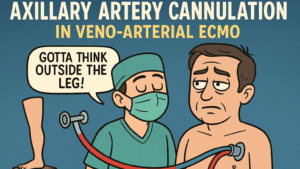Cardiac myxomas are the most common primary tumors of the heart, albeit rare, with an incidence of 1.38 per 100,000 individuals annually. Most cardiac myxomas are benign and often present in the left atrium. These tumors can cause serious complications, including obstruction of blood flow and systemic embolization. This article reports a compelling case of a 33-year-old woman who presented with acute bilateral lower limb ischemia, a rare but significant manifestation of left atrial myxoma.
The patient, a young Caucasian smoker with a history of endometriosis, experienced worsening pain in both legs before her emergency admission. Diagnostic imaging, including transthoracic echocardiography (TTE) and computed tomography (CT), revealed a large, pedunculated myxoma measuring 5.1 x 2.5 x 2.8 cm in her left atrium. The tumor extended through the mitral valve into the left ventricle, causing moderate mitral stenosis and systemic embolization. Lower limb Doppler studies confirmed occlusive thrombi in the popliteal arteries of both legs. Aspiration thrombectomy recovered gelatinous material later identified as fragments of the myxoma, restoring perfusion to the affected limbs.
Cardiac myxomas are known for their friable, gelatinous consistency, making them prone to fragmentation and embolization. While emboli in the central nervous system can cause devastating strokes, the peripheral emboli in this case were fortunate to affect tissues with a higher tolerance for ischemia. Nevertheless, the condition required urgent surgical intervention to prevent further complications.
The patient underwent successful open-heart surgery to excise the tumor through a median sternotomy. A right atriotomy provided access to the left atrium, where the myxoma was meticulously excised along with its stalk. The surgical team used a bovine pericardial patch to reconstruct the atrial septum, ensuring complete removal while minimizing the risk of residual fragments. Postoperative transesophageal echocardiography (TEE) confirmed the absence of any residual tumor, and the patient had an uneventful recovery.
Histopathological examination of the excised tumor confirmed it was a myxoma, characterized by stellated and polygonal cells within a myxoid matrix. Immunohistochemical staining was positive for CD31, CD34, and calretinin, markers that distinguish myxomas from other cardiac tumors. No bacterial growth was detected in cultures from the tumor tissue, and the findings ruled out any infectious complications.
Cardiac imaging played a critical role in the diagnosis and management of this case. TTE and Doppler studies provided initial evidence of the tumor and emboli, while CT scans further detailed the tumor’s morphology and its impact on surrounding structures. Although MRI could offer superior tissue characterization, its availability and cost limitations make echocardiography and CT practical alternatives in many cases.
This case underscores the urgency of surgical intervention for cardiac myxomas, even in the absence of severe symptoms. Left atrial myxomas can lead to sudden cardiac death or severe embolic events, such as stroke or limb ischemia, if left untreated. Prompt surgical removal not only prevents these complications but also offers a definitive cure, as the recurrence rate for sporadic myxomas is extremely low. Delays in treatment can increase the likelihood of life-threatening outcomes, particularly in tumors prone to fragmentation and embolization.
The discussion also touches on the origins and histological features of cardiac myxomas. These tumors are believed to arise from embryonic mesenchymal cells and are influenced by vascular endothelial growth factors that promote angiogenesis. While most cases are sporadic, some are associated with genetic conditions like Carney complex, which necessitates genetic counseling and closer follow-up. In this patient, no genetic abnormalities were identified, and the tumor was deemed sporadic.
The authors advocate for a “hit hard and early” approach to managing myxomas, prioritizing immediate surgical intervention upon diagnosis. This strategy minimizes the risk of embolization and ensures optimal patient outcomes. The patient in this case exemplifies the benefits of such an approach, returning to her normal activities post-surgery with no signs of recurrence.
In conclusion, cardiac myxomas, though rare, require vigilance and timely treatment to prevent catastrophic complications. This case highlights the importance of interdisciplinary collaboration, advanced imaging techniques, and meticulous surgical planning in achieving successful outcomes for patients with this potentially life-threatening condition.







